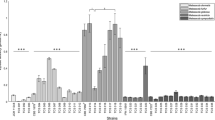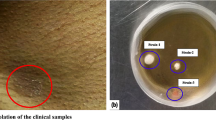Abstract
Members of the yeast genus Malassezia, including atypical strains, are lipophilic except for Malassezia pachydermatis. New physiological features that characterize atypical Malassezia strains are mainly associated with alteration in Tween assimilation pattern — such isolates still require lipids for growth. We isolated three non-lipid-dependent strains of Malassezia from patients with diagnosed atopic dermatitis (AD). These isolates could not be identified to the species level via their physiological properties. Phylogenetic trees, based on the D1/D2 regions of the 26S rDNA gene sequences and nucleotide sequences of the ITS1-5.8S-ITS2 rRNA region, showed the isolates to belong to Malassezia furfur. Three non-lipid dependent isolates from AD skin were conspecific, and sequences analysis proved them to be M. furfur.
Similar content being viewed by others
References
Ahearn D.G., Simmons R.B., Malassezia Baillon, In: Kurtzman C.P., Fell J.W. (Eds.), The Yeasts. A Taxonomic Study, 4th ed., Elsevier Science Publishing, Amsterdam, 1998
Guého E., Midgley G., Guillot J., The genus Malassezia with the description of four new species, A Van Leeuw J Microb, 1996, 36, 337–355
Sugita T., Takashima M., Shinoda T., Suto H., Unno T., Tsuboi R., et al., A New yeast species, Malassezia dermatis, isolated from patients with atopic dermatitis, J. Clin. Microbiol., 2002, 40, 1363–1367
Sugita T., Takashima M., Kodama M., Tsuboi R., Nishikawa A., Description of a new yeast species, Malassezia japonica, and its detection in patients with atopic dermatitis and healthy subjects, J. Clin. Microbiol., 2003, 41, 4695–4699
Sugita T., Tajima M., Takashima M., Amaya M., Saito M., Tsuboi R., et al., A new yeast, Malassezia yamatoensis, isolated from a patient with seborrheic dermatitis, and its distribution in patients and healthy subjects, Microbiol. Immunol., 2004, 48, 579–583
Hirai A., Kano R., Makimura K., Duarte E.R., Hamdan J.S., Lachance M.A., et al., Malassezia nana sp. nov., a novel lipid-dependent yeast species isolated from animals, Int. J. Syst. Evol. Microbiol., 2004, 54, 623–627
Cabañes F.J., Theelen B., Castellá G., Boekhout T., Two new lipid-dependent Malassezia species from domestic animals, FEMS Yeast Res., 2007, 7, 1064–1076
Cabañes F.J., Vega S., Castellá G., Malassezia cuniculi sp. nov., a novel yeast species isolated from rabbit skin, Med. Mycol., 2011, 49, 40–48
Nakabayashi A., Sei Y., Guillot J., Identification of Malassezia species isolated from patients with seborrhoeic dermatitis, atopic dermatitis, pityriasis versicolor and normal subjects, Med. Mycol., 2000, 38, 337–341
Ashbee H.R., Evans E.G.V., Immunology of Diseases Associated with Malassezia Species, Clin. Microbiol. Rev., 2002, 15, 21–57
DeAngelis Y.M., Gemmer C.M., Kaczvinsky J.R., Kenneally D.C., Schwartz J.R., Dawson T.L.Jr., Three etiologic facets of dandruff and seborrheic dermatitis: Malassezia fungi, sebaceous lipids, and individual sensitivity, J. Investig. Dermatol. Symp. Proc., 2005, 10, 295–297
Crespo-Erchiga V., Florencio V.D., Malassezia yeasts and pityriasis versicolor, Curr. Opin. Infect. Dis., 2006, 19, 139–147
Darabi K., Hostetler S.G., Bechtel M.A., Zirwas M., The role of Malassezia in atopic dermatitis affecting the head and neck of adults, J. Am. Acad. Dermatol., 2009, 60, 125–136
Akdis C.A., Akdis M., Bieber T., Bindslev-Jensen C., Boguniewicz M., Eigenmann P., et al., Diagnosis and treatment of atopic dermatitis in children and adults: European Academy of Allergology and Clinical Immunology/American Academy of Allergy, Asthma and Immunology/PRACTALL Consensus Report, Allergy, 2006, 61, 969–987
Xu J., Saunders C.W., Hu P., Grant R.A., Boekhout T., Kuramae E.E., et al., Dandruff-associated Malassezia genomes reveal convergent and divergent virulence traits shared with plant and human fungal pathogens, Proc. Natl. Acad. Sci. USA, 2007, 104, 18730–18735
Duarte E.R., Lachance M.A., Hamdan J.S., Identification of atypical strains of Malassezia spp. from cattle and dog, Can. J. Microbiol., 2002, 48, 749–752
Kaneko T., Makimura K., Abe M., Shiota R., Nakamura Y., Kano R., et al., Revised Culture-Based System for Identification of Malassezia Species, J. Clin. Microbiol., 2007, 45, 3737–3742
González A., Sierra R., Cárdenas M.E., Grajales A., Restrepo S., Cepero de Garcia M.C., et al., Physiological and Molecular Characterization of Atypical Isolates of Malassezia furfur, J. Clin. Microbiol., 2009, 47, 48–53
Cafarchia C., Latrofa M.S., Figueredo L.A., da Silva Machado M.L., Ferreiro L., Guillot J., et al, Physiological and molecular characterization of atypical lipid-dependent Malassezia yeasts from a dog with skin lesions: adaptation to a new host?, Med. Mycol., 2011, 49, 365–374
Crespo M.J., Abarca M.L., Cabanes F.J., Atypical lipid-dependent Malassezia species isolated from dogs with otitis externa, J. Clin. Microbiol., 2000, 38, 2383–2385
Cafarchia C., Latrofa M.S., Testini G., Parisi A., Guillot J., Gasser R.B., et al., Molecular characterization of Malassezia isolates from dogs using three distinct genetic markers in nuclear DNA, Moll. Cell Probes, 2007, 21, 229–238
Guillot J., Guého E., Lesourd M., Midgley G., Chevrier G., Dupont B., Identification of Malassezia species, a practical approach, J. Mycol. Med., 1996, 6, 103–110
Mayser P., Haze P., Papavassilis C., Pickel M., Gruender K., Guého E., Differentiation of Malassezia species: selectivity of cremphor EL, castor oil and ricinoleic acid for M.furfur, Br. J. Dermatol., 1997, 137, 208–213
Mayser P., Wille G., Imkampe A., Thoma W., Arnold N., Monsees T., Synthesis of fluorochromes and pigments in Malassezia furfur by use of tryptophan as the single nitrogen source, Mycoses, 1998, 41, 265–271
Mayser P., Töws A., Krämer H.J., Weiß R., Further characterization of pigment-producing Malassezia strains, Mycoses, 2004, 47, 34–39
Fell J.W., Boekhout T., Fonseca A., Scorzetti G., Statzell-Tallmann A., Biodiversity and systematic of basidiomycetous yeasts as determined by largesubunit rDNA D1/D2 domain sequence analysis, Int. J. Syst. Evol. Microbiol., 2000, 50, 1351–1371
Sugita T., Nishikawa A., Ikeda R., Shinoda T., Identification of medically relevant Trichosporon species based on sequences of internal transcribed spacer regions and construction of a database for Trichosporon identification, J. Clin. Microbiol., 1999, 37, 1985–1993
Tamura K., Dudley J., Nei M., Kumar S., MEGA4: Molecular Evolutionary Genetics Analysis (MEGA) software version 4.0, Mol. Biol. Evol., 2007, 24, 1596–1599
Tamura K., Nei M., Kumar S., Prospects for inferring very large phylogenies by using the neighborjoining method, Proc. Natl. Acad. Sci. USA, 2004, 101, 11030–11035
Saitou N., Nei M., The neighbor-joining method: A new method for reconstructing phylogenetic trees, Mol. Biol. Evol., 1987, 4, 406–425
Felsenstein J., Confidence limits on phylogenies: an approach using the bootstrap, Evolution., 1985, 39, 783–791
Scorzetti G., Fell J.W., Fonseca A., Statzell-Tallman A., Systematics of basidiomycetous yeasts: a comparison of large subunit D1/D2 and internal transcribed spacer rDNA regions, FEMS Yeast Res., 2002, 2, 495–517
Batra R, Boekhout T., Gueho E., Cabanes F.J., Dawson T.L., Gupta A.K., Malassezia Baillon, emerging clinical yeasts, FEMS Yeast Res., 2005, 5, 1101–1113
Brunke S., Hube B., MfLIP1, a gene encoding an extracellular lipase of the lipid-dependent fungus Malassezia furfur, Microbiology, 2006, 152, 547–554
Cafarchia C., Otranto D., Association between phospholipase production by Malassezia pachydermatis and skin lesions, J. Clin. Microbiol., 2004, 42, 4868–4869
DeAngelis Y.M., Saunders C.W., Johnstone K.R., Reeder N.L., Coleman C.G., Kaczvinsky J.R., et al., Isolation and expression of a Malassezia globosa lipase gene, LIP1, J. Invest. Dermatol., 2007, 127, 2138–2146
Pini G., Faggi E., Extracellular phospholipase activity of Malassezia strains isolated from individuals with and without dermatological disease, Rev. Iberoam., Micol., 2011, 28, 179–182
Bond R., Anthony R.M., Characterization of markedly lipid-dependent Malassezia pachydermatis isolates from healthy dogs, J. Appl. Microbiol., 1995, 78, 537–542
Morris D.O., Malassezia pachydermatis carriage in dog owners, Emerg. Infect. Dis., 2005, 11, 83–88
Crespo M.J., Abarca M.L., Cabanes F.J., Occurrence of Malassezia spp. in horses and domestic ruminants, Mycoses, 2002, 45, 333–337
Gandra R.F., Gambale W., de Cassia Garcia Simao R., da Silva Ruiz L., Durigon E.L., de Camargo L.M., et al., Malassezia spp.in acoustic meatus of bats (Molossus molossus) of the Amazon Region, Brazil, Mycopathologia, 2008, 165, 21–26
Tanaka R., Nishimura K., Kamei K., Murayama S.Y., Assimilation test of Malassezia furfur isolated from the environment, Nihon. Ishinkin., Gakkai. Zasshi., 2001, 42, 123–126
Gupta A.K., Boekhout T., Theelen B., Summerbell R., Batra R., Identification and Typing of Malassezia Species by Amplified Fragment Length Polymorphism and Sequence Analyses of the Internal Transcribed Spacer and Large-Subunit Regions of Ribosomal DNA, J. Clin. Microbiol., 2004, 42, 4253–4260
Gandra R.F., Simão R.C., Matsumoto F.E., da Silva B.C.M., Ruiz L.S., da Silva E.G., et al., Genotyping by RAPD-PCR analyses of Malassezia furfur strains from pityriasis versicolor and seborrhoeic dermatitis patients, Mycopathologia, 2006, 162, 273–280
Takahata Y., Sugita T., Kato H., Nishikawa A., Hiruma M., Muto M., Cutaneous Malassezia flora in atopic dermatitis differs between adults and children, Br. J. Dermatol., 2007, 157, 1178–1182
Gaitanis G., Bassukas I.D., Velegraki A., The range of molecular methods for typing Malassezia, Curr. Opin. Infect. Dis., 2009, 22, 119–125
Zinkeviciene A., Vaiciulioniene N., Baranauskiene I., Kvedariene V., Emuzyte R., Citavicius D., Cutaneous yeast microflora in patients with atopic dermatitis, Cent. Eur. J. Med., 2011, 6, 713–719
Yim S.M., Kim J.Y., Ko J.H., Lee Y.W., Choe Y.B., Ahn K.J., Molecular analysis of Malassezia microflora on the skin of the patients with atopic dermatitis, Ann. Dermatol., 2010, 22, 41–47
Saghazadeh M., Farshi S., Hashemi J., Mansouri P., Khosravi A.R., Identification of Malassezia species isolated from patients with seborrheic dermatitis, atopic dermatitis, and normal subjects, J. Mycol. Med., 2010, 20, 279–282
Midgley G., The lipophilic yeasts: state of the art and prospects, Med. Mycol., 2000, 38, 9–16
Gupta A.K., Batra R., Bluhm R., Boekhout T., Dawson T.L., Jr., Skin diseases associated with Malassezia species, J. Am. Acad. Dermatol., 2004, 51, 785–798
Crespo E.V., Delgado F.V., Malassezia species in skin diseases, Curr. Opin. Infect. Dis., 2002, 15, 133–142
Staib P., Wirsching S., Strauss A., Morschhauser J., Gene regulation and host adaptation mechanisms in Candida albicans, Int. J. Med. Microbiol., 2001, 291, 183–188
Caprilli F., Mercantini R., Nazzaro-Porro M., Passi S., Tonolo A., Studies of the genus Pityrosporum in submerged culture, Mycopathol. Mycol. Appl., 1973, 51, 171–189
Morrow C.A., Fraser J.A., Sexual reproduction and dimorphism in the pathogenic basisiomycetes, FEMS Yeast Res., 2009, 9, 161–177
Butler G., Fungal sex and pathogenesis, Clin. Microbiol. Rev., 2010, 23, 140–159
Midreuil F., Guillot J., Gueho E., Renaud F., Mallie M., Bastide J.M., Genetic diversity in the yeast species Malassezia pachydermatis analysed by multilocus enzyme electrophoresis, Int. J. Syst. Bacteriol., 1999, 49, 1287–1294
Mittag H., Fine structural investigation of Malassezia furfur: I. Size and shape of the yeast cells and a consideration of their ploidy, Mycoses, 1994, 37, 393–399
Paulino L.C., Tseng C.H., Strober B.E., Blaser M.J., Molecular analysis of fungal microbiota in samples from healthy human skin and psoriatic lesions, J. Clin. Microbiol., 2006, 44, 2933–2941
Zhang E., Tanaka T., Tajima M., Tsuboi R., Nishikawa A., Sugita T., Characterization of the skin fungal microbiota in patients with atopic dermatitis and healthy subjects, Microbiol. Immunol., 2011, 55, 625–632
Author information
Authors and Affiliations
Corresponding author
About this article
Cite this article
Zinkeviciene, A., Norkunas, V. & Citavicius, D. Atypical non-lipid-dependent strains of Malassezia furfur . cent.eur.j.biol. 7, 241–249 (2012). https://doi.org/10.2478/s11535-012-0018-3
Received:
Accepted:
Published:
Issue Date:
DOI: https://doi.org/10.2478/s11535-012-0018-3




